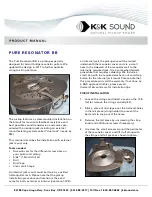
61
Maintenance and Storage
Figure 81
Sensor module
replacement
Sensor modules for pH, pH/ORP, nitrate, ammonium, and chloride all require periodic replacement. Perform a sensor
module replacement in a clean, dry laboratory environment. Remove the sensor from the bulkhead and perform the
following steps:
Module Replacement
1.
Peel off and discard the sticker that covers the junction of the
sensor body and the module (
Figure 81
).
2.
With a small, flat-blade screwdriver, carefully remove the square
rubber plug from the gap in the hard plastic ring at the base of the
sensor module.
3.
Using two fingers, squeeze the sensor module’s hard plastic ring
so that it compresses the gap left by the rubber plug.
4.
While squeezing, steadily pull the sensor module straight from the
sensor body, rocking slightly if necessary. Do not keep the used
o-rings as they are unusable after removal from the sensor body.
Discard the old sensor module.
5.
Inspect the sensor connector port for debris or moisture.
If detected, remove it with lint-free cloth or a light blast of
compressed air.
6.
The new sensor module comes with two o-rings installed and
pre-lubricated. Visually inspect the o-rings for nicks, tears,
contaminants or particles. Replace any damaged o-rings.
NOTICE:
If a sensor module is removed for any reason, the o-rings
must be replaced.
7.
Align the prongs on the base of the sensor module with the slots
in the sensor body. The sensor module is keyed to insert in only
one orientation. Push the sensor module firmly into position until
it clicks. Wipe any excess o-ring lubricant from the assembled
components.
8.
Wrap the junction of the sensor module and sensor body with the
new sticker included in the sensor module kit. The sticker helps
keep the sensor module junction clean and retain the rubber plug
throughout deployment.
9.
Write the replacement date on the sticker.
NOTE:
Be sure to calibrate the sensor after module replacement.
4.11
ProDSS Sensor Module Replacement
















































